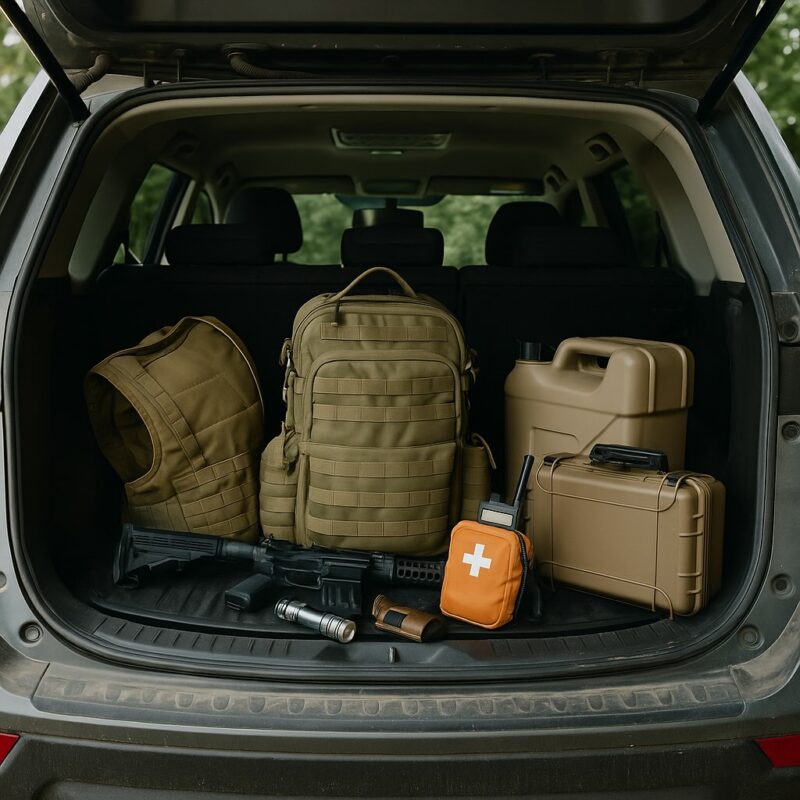Gear, Learning, Prepper's Corner
Bug-Out Vehicle Essentials: What Every Prepper Should Keep in Their Ride
Why Your Vehicle Is Your Lifeline
In a true emergency — natural disaster, power grid failure, civil unrest — your bug-out vehicle becomes more than just a way to get from A to B. It’s your mobile stronghold. A prepper’s vehicle isn’t just transportation — it’s a rolling fortress of mobility, self-reliance, and readiness.
If you’re serious about prepping, having your vehicle properly outfitted is non-negotiable. This post covers the critical supplies, gear, and tactical modifications every prepper should keep in their ride.
1. The Foundation: What Makes a Good Bug-Out Vehicle?
Let’s start with the vehicle itself. You don’t need a $70,000 tactical SUV — but you do need reliability and off-road capability. Here’s what to look for:
- 4WD or AWD drivetrain – Escape routes aren’t always paved.
- Good ground clearance – Essential for navigating debris, rough roads, or off-grid terrain.
- Long range fuel capacity – Or mods that let you extend it (extra jerry cans, rooftop fuel storage).
- Durability – Simple, older models often win out (less reliance on computerized systems).
Common platforms among preppers include older Toyota 4Runners, Jeep Wranglers, Ford Rangers, and Subaru Outbacks.
2. Core Bug-Out Vehicle Supplies
Here’s what should always be in your rig. These items turn your vehicle into a true survival platform.
🔧
Mechanical Tools & Vehicle Maintenance
- Jumper cables
- Battery jump starter (preferably lithium-based, with USB ports)
- Tire inflator & pressure gauge
- Fix-a-Flat or tire plug kit
- Socket wrench set
- Spare belts and fuses
- Emergency fuel siphon
🛠️
Recovery & Mobility Gear
- Tow straps and shackles
- Folding shovel (aka e-tool)
- Traction boards (Maxtrax or similar)
- Jack (bottle or farm-style, not just the factory jack)
- Portable air compressor
- Work gloves
3. Survival Gear Onboard
This is where your bug-out prep gets serious. Think of your vehicle as a temporary home.
🔥
Fire & Warmth
- Firestarter (ferro rod, waterproof matches)
- Wool blankets or thermal space blankets
- Cold-weather gloves and hat
- Emergency hand warmers
💧
Water & Hydration
- Water filter (LifeStraw, Sawyer, or pump-based filter)
- 1–2 gallons of stored water minimum
- Collapsible water containers
- Electrolyte packets
🍫
Food & Nutrition
- MREs or freeze-dried meals
- High-calorie survival bars (like Datrex or SOS)
- Can opener
- Utensils & camp cup
- Small propane stove or alcohol burner
4. Tactical Essentials
You never want to be caught unarmed or blind.
🔦
Lighting & Signaling
- Tactical flashlight (plus backup)
- Red LED for preserving night vision
- Glow sticks (long-lasting, low signature)
- Road flares or LED safety triangles
🧭
Navigation & Comms
- Paper maps of your area and escape routes
- Compass
- Handheld radio (HAM, GMRS, or CB)
- Backup GPS device (Garmin or similar)
🧯
Defense & Protection
- Personal defense tools (firearm, pepper spray, etc.) — local laws apply
- Ballistic protection (plate carrier stored flat under a seat)
- Fixed-blade survival knife
- Window breaker & seatbelt cutter
5. First Aid & Trauma Kit
Every bug-out vehicle should have a real first-aid kit — not just Band-Aids and Tylenol.
Include:
- Tourniquet (CAT or SOF-T)
- Israeli bandage
- Hemostatic gauze
- Chest seals
- Burn cream
- Trauma shears
- Nitrile gloves
- CPR mask
- Medications (pain relievers, antihistamines, personal prescriptions)
If you don’t know how to use these items — train now. A trauma kit without knowledge is just extra weight.
6. Storage and Loadout Tips
- Use modular bags or bins to organize by category (tools, medical, food, etc.)
- Keep quick-access gear (like your weapon or flashlight) within arm’s reach
- Mount MOLLE panels to the back of seats for tactical gear storage
- Consider roof racks or rear hitch storage to expand your carry capacity
7. Optional But Powerful Add-Ons
If your budget allows:
- Roof-mounted solar panel (plus battery bank)
- CB/HAM radio antenna mount
- Onboard water tank with gravity feed
- Tinted or blackout windows for OPSEC
- Dash cam or surveillance system
8. Keep It Legal. Keep It Ready.
You want your bug-out vehicle ready — but also street-legal. Keep your registration, insurance, and license updated. Avoid unlawful mods that attract attention (e.g. full blackout lighting without toggles).
And yes — drive it regularly. Don’t let your BOV rot in a garage. Rotate fuel, check battery life, and inspect stored gear every month.
Final Word
When SHTF, your bug-out vehicle might be the only thing between you and total chaos. Equip it like your life depends on it — because one day, it just might.


